PART I: DIGITAL PIANO ACTIONS
The importance of a digital piano’s action cannot be understated. The ability to play dynamically is what makes a piano a “piano” (its original name was piano-forte which translates into “soft and loud”). It doesn’t matter how many gigabytes have been sampled, or how advanced the modelled resonances are – if a digital piano’s action is sub-par, it won’t afford the player the control needed to play dynamically and ultimately the instrument will not be satisfying to play. Kawai’s ability to transfer its expertise in acoustic pianos into their digital pianos may be most evident in their line-up of digital actions, which can be split into two categories: wooden-key and plastic key.WOODEN-KEY ACTIONS

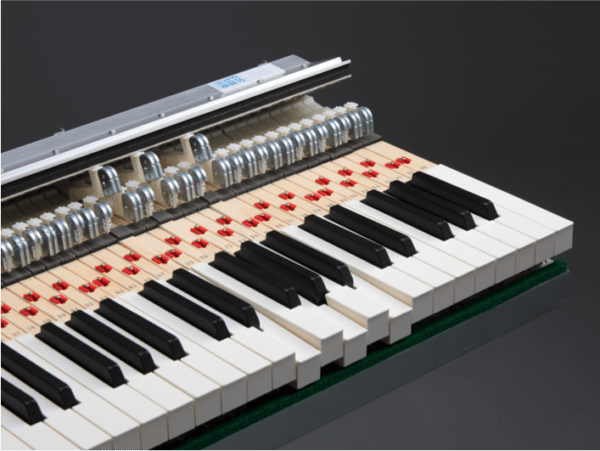

Adapted exclusively for the NV-10, the Millennium III hybrid grand piano action is nearly identical to the actions found in Kawai’s GL and GX series of grand pianos. The traditional felt hammers are replaced with ABS equivalents that are individually weighted and balanced from bass to treble. Optical sensors take the place of metal strings, which read the subtle movements of each hammer as the corresponding keys are played. They are more accurate than key-based sensors and, as they are contact-less, do not suffer physical wear and tear.
It is important to note that certain features found on high-end digital pianos, such as triple-sensor and let-off, are meant to simulate an acoustic grand piano action. Because the Millennium III hybrid grand action is an acoustic piano action, these features are inherent.
Taking the authenticity of feel to a new level, there is a grand piano damper mechanism that alters the touch weight of the keys when the sustain pedal is engaged. While there are no strings inside that would require damping, the touch weight is lightened just as it is in an acoustic grand piano. It is truly revolutionary.
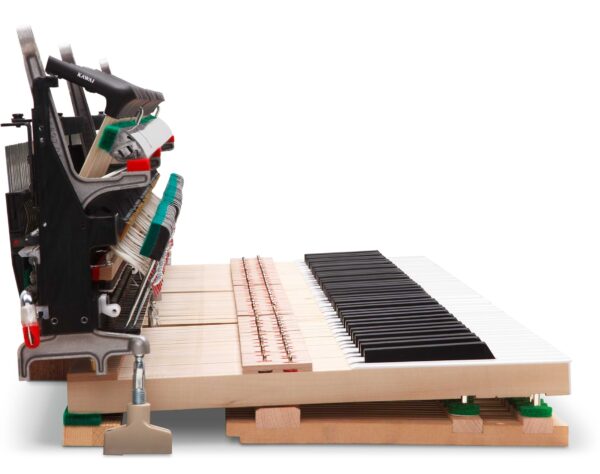
Adapted exclusively for the NV-5, the Millennium III hybrid upright piano action is nearly identical to the actions found in Kawai’s K-series of upright pianos. The traditional felt hammers are replaced with ABS equivalents that are individually weighted and balanced from bass to treble. Optical sensors take the place of metal strings, which read the subtle movements of each hammer as the corresponding keys are played. They are more accurate than key-based sensors and, as they are contact-less, do not suffer physical wear and tear.
Taking the authenticity of feel to a new level, there is a grand piano damper mechanism that alters the touch weight of the keys when the sustain pedal is engaged. While there are no strings inside that would require damping, the touch weight is lightened just as it is in an acoustic grand piano. It is truly revolutionary.
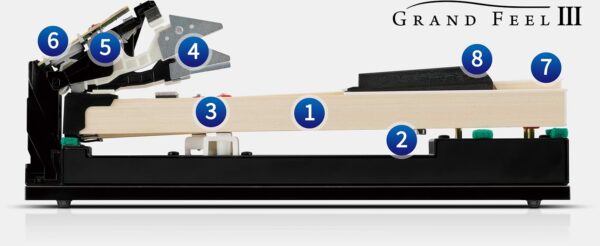
1. Long wooden keys
All 88 black and white keys are crafted entirely from long pieces of wood. They are as long as a traditional grand piano key, which is 2″ longer than most digital keys. This additional length allows the player to better control playing softly.2. Counterweights
The weight required to press the keys increases as you move from the treble to the bass. Counterweights are needed to “balance” the touch-weight.3. Balance Pins
The balance pin anchors the key and allows it to “rock” back and forth as acoustic piano keys do.4. Weighted hammers
Each key has a grade-weighted hammer which simulates the weight and movement of an acoustic piano’s felt hammers.5. Let-Off Mechanism
There is a subtle “notch” sensation that can be felt when playing the keys of a grand piano very gently and is used by experienced pianists to help control playing pianissimo passages. These actions also support playing notes from the let-off point (sometimes referred to as playing “off the jack”). The Grand Feel III reproduces this let-off characteristic.6. Triple-Sensor
The triple-sensor improves responsiveness when playing the same key repeatedly and, unlike conventional two sensor keyboard actions, allows the same note to be struck a second time to produce a sound without losing the sound of the initial strike. This feature imitates the physical action of a grand piano (uprights do not repeat notes in the same fashion and are incapable of re-sounding the same note). Additionally, the third sensor monitors the speed at which each key is lifted, influencing the release character of the sound, providing an audible change in decay when going from staccato to legato.7. Ivory Touch Surface
Kawai’s Ivory Touch key surface is finely textured material engineered to wick away perspiration and oils to assist playing control. They possesss a natural, matte finish.8. Ebony Touch Surface
Kawai’s Ebony Touch key surface is an all-black key material that reproduces the finely-textured grain and rich lustre of real ebony wood. It also wicks away perspiration and oils. The MP-11 uses the Grand Feel I action which has the same features as the Grand Feel III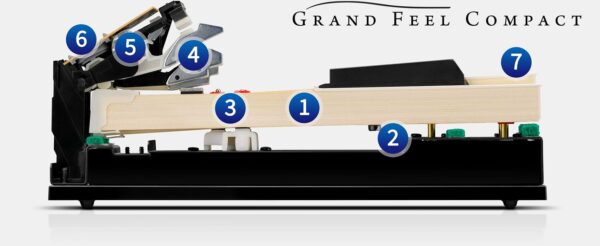
1. Long wooden keys
All 88 black and white keys are crafted entirely from long pieces of wood. Unlike plastic key actions, these wooden keys extend beyond their pivot point giving the action an authentic feeling.2. Counterweights
The weight required to press the keys increases as you move from the treble to the bass. Counterweights are needed to “balance” the touch-weight.3. Balance Pins
The balance pin anchors the key and allows it to “rock” back and forth as acoustic piano keys do.4. Weighted hammers
Each key has a grade-weighted hammer which simulates the weight and movement of an acoustic piano’s felt hammers.5. Let-Off Mechanism
There is a subtle “notch” sensation that can be felt when playing the keys of a grand piano very gently and is used by experienced pianists to help control playing pianissimo passages. These actions also support playing notes from the let-off point (sometimes referred to as playing “off the jack”). The Grand Feel III reproduces this let-off characteristic.6. Triple-Sensor
The triple-sensor improves responsiveness when playing the same key repeatedly and, unlike conventional two sensor keyboard actions, allows the same note to be struck a second time to produce a sound without losing the sound of the initial strike. This feature imitates the physical action of a grand piano (uprights do not repeat notes in the same fashion and are incapable of re-sounding the same note). Additionally, the third sensor monitors the speed at which each key is lifted, influencing the release character of the sound, providing an audible change in decay when going from staccato to legato.7. Ivory Touch Surface
Kawai’s Ivory Touch key surface is finely textured material engineered to wick away perspiration and oils to assist playing control. They possesss a natural, matte finish.
It doesn’t matter how many gigabytes have been sampled, or how advanced the modelled resonances are, if the controller’s action is sub-par, the virtual piano just won’t feel satisfying to play.
Fortunately, the VPC-1 is equipped with Kawai’s RM3 II action, featuring authentic wooden keys with a smooth, consistent movement. It incorporates grand piano keyboard characteristics such as graded-hammer weighting, ivory-like key surfaces, let-off simulation, and bass note counterweights.
These premium features combine to recreate the exceptional touch of a grand piano, allowing your favourite virtual pianos to finally feel as good as they sound.
PLASTIC KEY ACTIONS
Kawai’s plastic key actions use an industry-standard design where the pivot point is placed at the back of the key, not in the middle. These actions utilize hammer components under the keys to create a mechanical movement similar to an acoustic piano. Additionally, the hammer weights are “graded” which simulates an acoustic piano action where the hammers are larger in the bass region and gradually get smaller as you move up the keyboard.
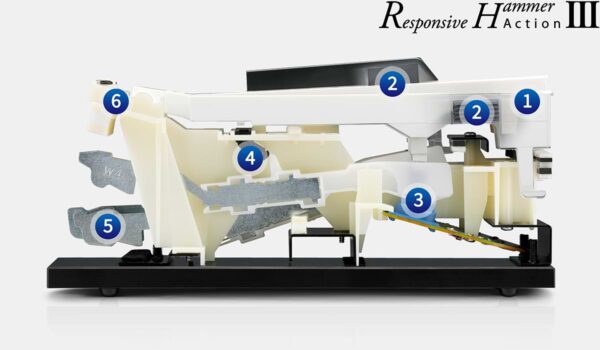 The Responsive Hammer III keyboard action has been developed to recreate the touch feeling of playing a grand piano. Each key is weighted using metal hammers which are “graded” (ie. slightly heavier in the bass region and lighter in the treble) just like an acoustic piano. These weights also allow released keys to return to their original position with-out the aid of springs, resulting in a smooth, natural playing experience.
The Responsive Hammer III keyboard action has been developed to recreate the touch feeling of playing a grand piano. Each key is weighted using metal hammers which are “graded” (ie. slightly heavier in the bass region and lighter in the treble) just like an acoustic piano. These weights also allow released keys to return to their original position with-out the aid of springs, resulting in a smooth, natural playing experience.
1. Ivory Touch Keys
Kawai’s Ivory Touch key surface is finely textured material engineered to wick away perspiration and oils to assist playing control. They possesss a natural, matte finish.2. Counterweights
The weight required to press the keys increases as you move from the treble to the bass. Counterweights are needed to “balance” the touch-weight.3. Triple Sensor
The triple-sensor improves responsiveness when playing the same key repeatedly and, unlike conventional two sensor keyboard actions, allows the same note to be struck a second time to produce a sound without losing the sound of the initial strike. This feature imitates the physical action of a grand piano (uprights do not repeat notes in the same fashion and are incapable of re-sounding the same note). Additionally, the third sensor monitors the speed at which each key is lifted, influencing the release character of the sound, providing an audible change in decay when going from staccato to legato.4. Let-Off Mechanism
There is a subtle “notch” sensation that can be felt when playing the keys of a grand piano very gently and is used by experienced pianists to help control playing pianissimo passages. These actions also support playing notes from the let-off point (sometimes referred to as playing “off the jack”). The Responsive Hammer III action reproduces this let-off characteristic.5. Weighted Hammers
Each key has a grade-weighted hammer which simulates the weight and movement of an acoustic piano’s felt hammers.6. Key Pivot Point
Though the pivot point length is industry standard, Kawai has designed the keys to slide into place before being locked into position unlike most plastic key actions which bend the key outward to snap it into position. The bending causes stress to the key and is often where they break.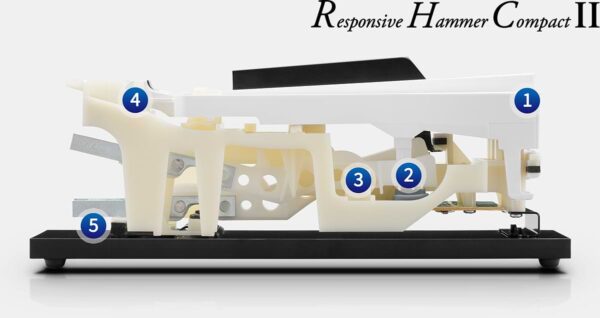
1. Matte Key Surface
The RHC-II action has matte key surfaces for a more natural and authentic look.2. Hammer Sensor
Sealed to prevent dust and debris from impacting its function, the hammer sensor evaluates key movement which is translated into the volume and tonal changes in the note’s sound. The RHC-II positions its hammer sensors far away from the key pivot point for increased precision.3. Hammer Pivot Point
The Responsive Hammer Compact II is so named because it tucks the hammer under the key. Its ergonomic design is spring-less and provides realistic key movement that is satisfying to play.4. Key Pivot Point
Though the pivot point length is industry standard, Kawai has designed the keys to slide into place before being locked into position unlike most plastic key actions which bend the key outward to snap it into position. The bending causes stress to the key and is often where they break.5. Weighted Hammers
Each key has a grade-weighted hammer which simulates the weight and movement of an acoustic piano’s felt hammers.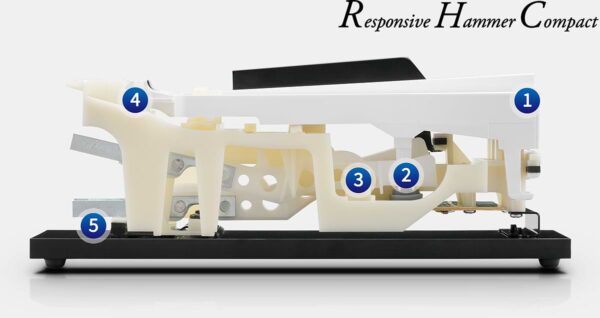
1. Matte Key Surface
The RHC-II action has matte key surfaces for a more natural and authentic look.2. Hammer Sensor
Sealed to prevent dust and debris from impacting its function, the hammer sensor evaluates key movement which is translated into the volume and tonal changes in the note’s sound. The RHC positions its hammer sensors far away from the key pivot point for increased precision.3. Hammer Pivot Point
The Responsive Hammer Compact is so named because it tucks the hammer under the key. Its ergonomic design is spring-less and provides realistic key movement that is satisfying to play.4. Key Pivot Point
Though the pivot point length is industry standard, Kawai has designed the keys to slide into place before being locked into position unlike most plastic key actions which bend the key outward to snap it into position. The bending causes stress to the key and is often where they break.5. Weighted Hammers
Each key has a grade-weighted hammer which simulates the weight and movement of an acoustic piano’s felt hammers.Kawai’s Grand Pianos In Depth
With approximately 9,000 moving parts, the piano may be the most complicated acoustic instrument ever built. There are dozens of components that must work in
Kawai’s Digitals: Part 5 – The Rest
PART V: THE REST Beyond simply being played as an instrument, digital pianos have other features that can enhance the musical experience. With built-in lesson
Kawai’s Digitals: Part 4 – Connectivity
PART IV: CONNECTIVITY The ability to connect with technology is one of the advantages of a digital piano. From using your piano as a Bluetooth
Kawai’s Digitals: Part 3 – Piano Realism
PART III: PIANO REALISM The last two articles have explored the various Kawai actions and sound technologies. Touch and tone are paramount to any piano,
Kawai’s Digitals: Part 1 – Actions
PART I: DIGITAL PIANO ACTIONS The importance of a digital piano’s action cannot be understated. The ability to play dynamically is what makes a piano
Kawai’s Digitals: Part 2 – Sound Technology
PART II: SOUND TECHNOLOGY Playing a piano can be a rewarding experience. The slightest change of pressure applied to a key not only affects the
Kawai’s Upright Pianos In Depth
To put pianos into perspective, an average automobile engine has around 300 parts, a violin has 90, a microscope has 14, and a piano has
Kawai Digital Comparison Chart
Digital pianos are always evolving. Kawai makes a real effort to advance the realism of digital pianos. Though their work is impressive and exciting, it

